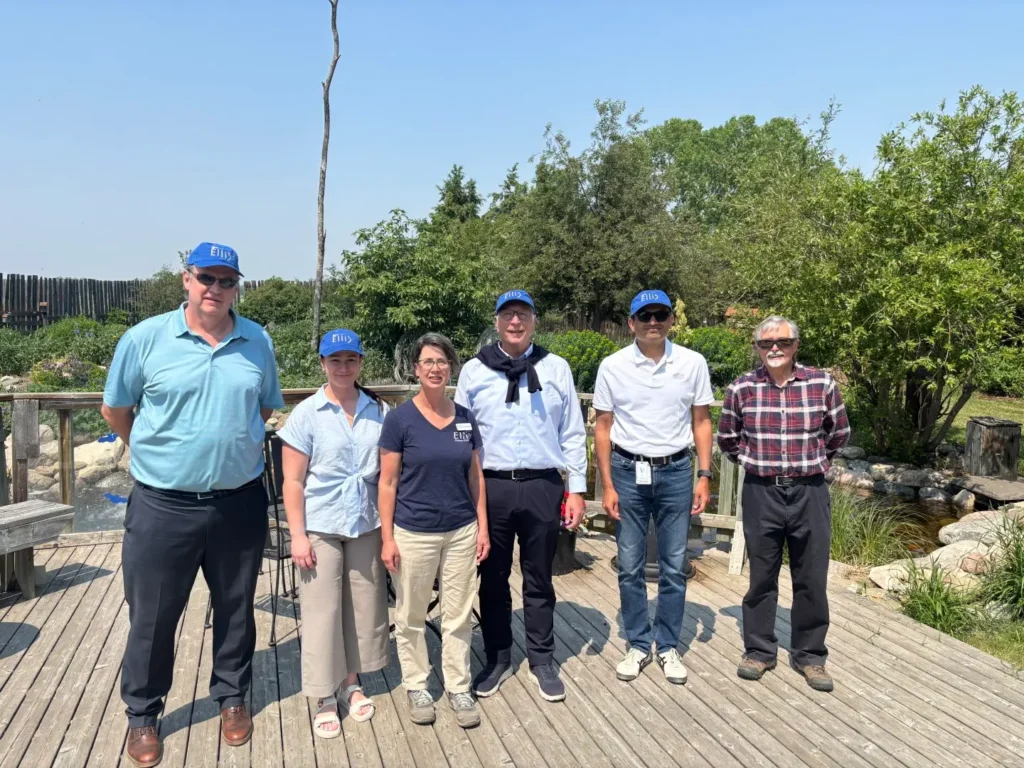Connecting Community
with Wildlife, Agriculture
& Industry

Connecting Community
with Wildlife, Agriculture & Industry

Ellis Nature Centre
Ellis Nature Centre is a non-profit organization dedicated to conservation, education & sustainable agriculture. We promote environmental education and wildlife conservation, monitor and conduct research on mountain bluebirds, tree swallows and purple martins, and manage over 480 acres of agricultural land. The Visitor Centre, original farmhouse, demonstration gardens and wetlands are set aside for wildlife and public enjoyment.
In 2024, we updated our name from Ellis Bird Farm to Ellis Nature Centre.
Join in the many activities and events of the season including the annual Bug Jamboree and Bluebird Festival.
Proud to be in partnership with MEGlobal, Ellis Nature Centre has established environmental education and conservation programs for secondary cavity nesting bird species, regenerative agriculture and scientific research.

Rocco Schurink, Vice President of Operations, North America; Kayle Yonkman, Vice President of Operations, Prentiss; Carolyn Ross, Site Manager; Dieter Schnepel, Vice President of Operations, Kuwait.
Visit Us!
Come explore our Visitor Centre site with a variety of gardens, historic grain elevator, network of nature trails, Wetland Activity Centre and children’s Nature Playground. Take a selfie at our historical grain elevator birdhouse wall!
Whether you are looking for a quiet stroll in the gardens or woods, you will find the tranquility and natural beauty of the site reinvigorating.
There are lots of activities for children to get outside and have fun! The Nature Playground, wetland exploration pond or the goats, chickens and honeybee pollinator interactive display, and scavenger hunt and children’s workshops and programming.
There is no entrance fee but donations are gratefully accepted.
Stewardship
Ellis Nature Centre is a working farm and showcases how agriculture industry can coexist with wildlife conservation. Our working farm continues Charlie Ellis’ conservation practices of delayed haying, preserving areas for wildlife and of course, the bluebird trail nest boxes. We conduct both avian research and regenerative agriculture practices here. Our bluebird trail has monitored mountain bluebird nest-boxes for over 50 years. We annually clean, repair the over 400 nest-boxes and during the summer months conduct weekly nest-box checks to collect data on population, first arrivals and parental care. We have been able to install solar powered nestbox cameras on several boxes to record the entire nesting period on Mountain bluebirds.
In 2022, we adopted new rotational grazing practices to better manage our grazing pastures. Adaptive multi-paddock grazing allows the land and plants time to recharge between rotations and improves water infiltration, forage production and soil health.
Education
Ellis Nature Centre is dedicated to providing immersive, hands-on outdoor education to the youth of Central Alberta. Just like Charlie and Winnie recognized when Ellis Bird Farm was established, we know that our youth are the next generation of environmental stewards and conservationists.
Our programs inspire a love of the outdoors, desire to protect nature, and dedication to giving back to our environment. Through our education program, children are not only inspired to become stewards of the land themselves, but to pass the values and knowledge they have learned onto others in their lives.
What's
happening

Land Acknowledgement
Ellis Nature Centre acknowledges that we work, play, and learn on Treaty 6 territory, traditional homeland of many First Nations, Metis, and Inuit groups since time immemorial. Additionally, we give thanks for all the teachings these groups have passed on about the importance of caring for and giving back to our natural spaces and the creatures we share those spaces with. On our continuous journey of reconciliation, we appreciate the teachings of Indigenous elders and community leaders about the importance of the land and our connection with it.
October 19, 2024
Definitely was worth the visit. It's beautiful here, they have done so much work. Beautiful displays of the wildlife, there are bridges, gazebos, ponds, birdhouses, flowers, plants, a very pretty place. Kids would definitely enjoy a visit here with a craft table and so many things for them to see. Take a lunch, there are lots of picnic tables to sit at and enjoy the views.
October 19, 2024
Beautiful hidden gem! Will definitely be coming back! Quiet and relaxing atmosphere for all ages! Kids have lots of areas to discover and play, peaceful walking paths and there's no fees for parking or to enter!
September 19, 2024
Visitor
Survey
Please fill out our visitor survey to share details about your visit to Ellis Nature Centre with us. We greatly appreciate your feedback and support!




